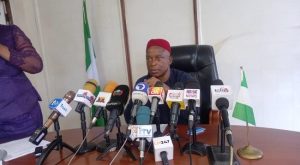The Nigeria Hydrological Services Agency (NIHSA) has said the study and design of the Dasin Hausa Dam to manage excess water from the Lagdo Dam in Cameroon had been completed and awaiting further reviews.

NIHSA Director General, Mr Clement Nze, disclosed that the dam was meant to be a buffer dam to curtail excess water released from Lagdo dam by the Cameroonian government.
According to him, the Federal Ministry of Water Resources and Sanitation had contacted the consultants in charge of the project and procurement would commence in no distant time.
The Dasin Hausa Dam was supposed to be two and half the size of the Lagdo Dam, which was built to supply electricity to the northern part of Cameroon and allow irrigation of 15,000 hectares of crops downstream.
The dam project sited at the Dasin Village of Fufore Local Government Area of Adamawa State is supposed to generate 300 megawatts of electricity and irrigate about 150,000 hectares of land in Adamawa, Taraba, and Benue states.
But, sadly, since 1982, the Nigerian government has yet to complete the building of the Dasin Hausa Dam, and it has not been listed as one of the priority or ongoing projects in the parent ministry.
A correspondent who sighted the copy of the 2023 appropriation for the ministry revealed that the study and design of the Dasin Hausa Dam was listed as ERGP28110523, as an ongoing project.
The Director in charge of Dams and Reservoir Operations, Federal Ministry of Water Resources and Sanitation, Mr Ali Dallah, declined comments on the status of the dam project, saying all questions should be directed to the Minister.
Meanwhile, a hydrologist, Mr Okechukwu Office, has identified environmental factors, urbanisation, and excessive rainfall as the cause of the current flooding in many parts of the country.
He said there was the need for state governments to partner with relevant agencies to ensure that people do not build on flood plains.
According to him, Nigerians are fixated on the release of excess water from the Lagdo Dam as the major cause of flooding in the country, saying this was untrue.
Offie said: “Lagdo Dam is not the major cause of flooding, it only contributes 10 per cent of water, there is the need to set up a structure within the Lagdo Dam to proactively monitor what’s coming into the dam ahead of time.
“Lagdo Dam is not different from any other dam, it’s about the size of Shiroro Dam which we have in Niger State. It’s not even as big as Kainji Dam. I want to make it clear that Lagdo Dam is not the cause of excessive flooding we have in Nigeria.”
He said that although the Nigerian government had prepared for flood under the hydro-Niger project many years ago, there was however the need to train and retrain more people in the water sector.
He said that for Nigeria to solve flooding in the country, all small rivers such as Katsina-Ala, Taraba, and Donga that spill into river Benue should have dams around them.
Offie, who is also a civil engineer, said building dams may not really be needed for flood control alone, as many flooding problems arose from increased water flows in the country.
He, however, called for the introduction of reservoir operations as a standard practice when dams are built so as to provide efficiency in water management and prevent panic releases.
Offie said: “We should do studies and determine which ones would need dams in them. If we build these dams, we must also do reservoir operations.
“Somewhere like Donga for instance that’s where they have the Mambilla hydro project, about three dams are going to be put there.
“In Katsina-Ala, we have one that is close to the Cameroon border, We can do another one further downstream, and so you put them in strategic locations to solve the problem.
“At the same time, if you build these dams, you must also do reservoir operations, if we don’t operate them, we will do panic releases and that is the cause of the problem.
“When suddenly you discover that the dam is going to give way, you open your gates, and you begin to put too much water into the system, so the work here is reservoir operations.”
The hydrologist urged the Federal Government to implement the recommendations of the Presidential Committee for the Development of a Comprehensive Plan of Action for Preventing flood disaster.
This, he said, would solve all the contending issues on flood control and management as proposed by the experts.
By Tosin Kolade
